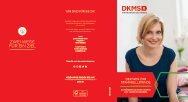You also want an ePaper? Increase the reach of your titles
YUMPU automatically turns print PDFs into web optimized ePapers that Google loves.
Philipp T.,<br />
former blood<br />
cancer patient<br />
The best<br />
cure for<br />
blood cancer<br />
is you<br />
A guide to stem<br />
cell donation
We need you!<br />
For a stem cell transplant to succeed, the donor and<br />
patient’s tissue markers must match as closely as possible.<br />
So, with several million possible HLA combinations occurring<br />
with different levels of frequency, there’s a fair chance<br />
that, somewhere out there, is a blood cancer patient<br />
whose only cure is you. If you think about that, then there’s<br />
really only one thing to do: register as a stem cell donor<br />
and give hope to blood cancer patients.<br />
DKMS regularly organizes donor drives across Germany to<br />
recruit new stem cell donors. To find out if there’s one going<br />
on near you, check out our website: dkms.de. Alternatively,<br />
request a swab kit online, use the three swabs to swab the<br />
inside of your cheeks, and get yourself registered at DKMS.<br />
More money, more chances<br />
At DKMS, we appreciate your financial support as well.<br />
Each registration of a new donor costs DKMS 40 euros.<br />
With your help, we can sign up even more new donors and<br />
give patients worldwide access to therapies. You will also<br />
be helping fund research into the best possible treatments<br />
for blood cancer patients.<br />
Thank you for your support!<br />
Donate to DKMS at<br />
Kreissparkasse Tübingen<br />
IBAN DE64 6415 0020 0000 2555 56<br />
BIC SOLADES1TUB<br />
As a registered DKMS stem cell donor, you could be the<br />
match that gives someone with blood cancer a second<br />
chance at life. So far, more than 12 million volunteers<br />
worldwide have signed up with us. With their fantastic<br />
help, we have been able to facilitate more than 110,000<br />
stem cell donations to date – and with them the chance of<br />
a new life. But still, many patients continue to wait for a<br />
suitable donor to be found. And that’s where you come in!<br />
Let’s fight blood cancer –<br />
together!<br />
Every 12 minutes, someone in Germany is diagnosed with<br />
blood cancer. Young or old, no one is safe from this disease.<br />
But together, we can help beat it – because your stem cell<br />
donation could give a patient a real chance of recovery.<br />
The challenge we face is this: for a stem cell transplant to<br />
succeed, the patient and donor’s tissue markers must<br />
match almost completely. So, the more donors we have,<br />
the greater the chances of finding a match.<br />
Sign up and help<br />
Essentially, every healthy individual between 17 and<br />
55 years of age can register as a potential stem cell<br />
donor. All that matters is that you are in good physical<br />
health and not affected by chronic illness.<br />
A simple cheek swab is enough to determine your tissue<br />
markers, and with your written consent, we’ll be happy to<br />
welcome you to DKMS right away. With a bit of luck, you<br />
too could give a blood cancer patient a second chance<br />
at life.<br />
This idea is so inspiring that entire families, companies,<br />
associations, and even countless celebrities have signed<br />
up for the good cause – and the number is rising every day.
Carlos S.,<br />
former blood<br />
cancer patient
Donating stem cells<br />
If your tissue markers turn out to match those of a patient,<br />
you will undergo further tests along with a thorough<br />
medical. DKMS will organize transport to and from your<br />
preliminary medical and donation for you, and also cover<br />
the costs. There are basically two ways of donating<br />
stem cells:<br />
“My donation saved a life.”<br />
Melina D.,<br />
stemm cell donor<br />
1. Peripheral stem cell collection<br />
Peripheral stem cell donation is currently the most widespread<br />
method of cell collection, accounting for 90% of<br />
all cases. It involves harvesting stem cells from the blood<br />
by a special procedure called apheresis. To do this, a needle<br />
is inserted into a large vein in each arm, much like when<br />
you donate blood. For the five days leading up to your<br />
donation, you will be given injections of the growth factor<br />
G-CSF, a naturally occurring hormone-like substance that<br />
increases the production and release of stem cells into<br />
the bloodstream. Peripheral stem cell donation takes<br />
around three to five hours. On rare occasions, donors may<br />
be asked to return for a second day of stem cell collection.<br />
When the growth factor is administered, some flu-like<br />
symptoms may occur, but an inpatient hospital stay won’t<br />
be necessary. According to research so far, there are no<br />
indications of any long-term side effects.<br />
2. Bone marrow collection<br />
Bone marrow is donated under general anesthesia, with<br />
about 1 liter of blood and marrow being removed from<br />
the back of the pelvic bone. This is the equivalent of<br />
approximately five percent of a donor’s entire bone marrow,<br />
which regenerates to its usual levels within a few weeks.<br />
Following the procedure, donors may experience localized<br />
pain that feels like bruising. They normally spend two or<br />
three days in hospital plus a few more days at home to<br />
recover, on the advice of the collection clinic. Bone marrow<br />
extraction is a low-risk procedure, but in rare cases, as<br />
with any surgical procedure, infections, bruising, or wound<br />
healing issues may occur. To rule out any avoidable risks,<br />
a thorough preliminary medical is our top priority.<br />
Become a stem cell<br />
donor today!<br />
Request your swab kit today at dkms.de. Swabbing your<br />
cheeks is easy and takes just a few minutes to do. You can<br />
even do it yourself, in the comfort of your own home.
Hope for blood<br />
cancer patients –<br />
DKMS at a glance.<br />
DKMS was founded on May 28, 1991, as a<br />
private initiative prompted by the story of<br />
blood cancer patient Mechtild Harf.<br />
DKMS currently has over 12 million potential<br />
stem cell donors. The non-profit operates not<br />
just in Germany but in the USA, Poland, the<br />
UK, Chile, India, and South Africa as well.<br />
Every day, 22 DKMS donors donate stem<br />
cells for blood cancer patients worldwide in<br />
57 countries – and counting!<br />
DKMS Donor Center gGmbH<br />
Kressbach 1<br />
72072 Tübingen<br />
Germany<br />
T +49 7071 943-0<br />
F +49 7071 943-1499<br />
post@dkms.de<br />
dkms.de<br />
Last update: 02/2024<br />
Follow us on:















